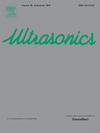Calculation of relative velocity change of coherent waves using improved stretching technique
IF 4.1
2区 物理与天体物理
Q1 ACOUSTICS
引用次数: 0
Abstract
The stretching cross-correlation technique is widely used in ultrasonic signal analysis to estimate relative wave velocity changes () for nondestructive testing and structural health monitoring. It enables high-resolution velocity measurements in the time domain without requiring extremely high sampling rates. In strongly scattering heterogeneous materials such as concrete and rock, is often used to detect temporal changes or damage. Acoustoelastic testing in metals relies on accurate measurement from coherent waves, where the applicability and accuracy of the stretching technique remain uncertain and insufficiently addressed in the literature. This study theoretically investigates the sources of error in the stretching method when applied to coherent waves and introduces a modified algorithm based on stretching the reference signal. Simulations show that the accuracy of estimation depends on multiple parameters, including the stretching window, wave transit time, and signal frequency. These factors are systematically analyzed in this study. The proposed method is validated through numerical simulations and experimental measurements of thermally induced velocity changes in a nylon specimen subjected to temperature variations.
用改进拉伸法计算相干波的相对速度变化
拉伸互相关法被广泛应用于超声信号分析中,以估计相对波速变化(dv/v0),用于无损检测和结构健康监测。它可以在时域内实现高分辨率的速度测量,而不需要极高的采样率。在混凝土和岩石等强散射非均质材料中,dv/v0常用于检测时间变化或损伤。金属的声弹性测试依赖于相干波的精确dv/v0测量,其中拉伸技术的适用性和准确性仍然不确定,并且在文献中没有充分解决。本文从理论上探讨了相干波拉伸方法的误差来源,并提出了一种基于参考信号拉伸的改进算法。仿真结果表明,dv/v0估计的精度取决于多个参数,包括拉伸窗口、波的传递时间和信号频率。本研究对这些因素进行了系统的分析。通过对温度变化下尼龙试样热致速度变化的数值模拟和实验测量,验证了该方法的有效性。
本文章由计算机程序翻译,如有差异,请以英文原文为准。
求助全文
约1分钟内获得全文
求助全文
来源期刊

Ultrasonics
医学-核医学
CiteScore
7.60
自引率
19.00%
发文量
186
审稿时长
3.9 months
期刊介绍:
Ultrasonics is the only internationally established journal which covers the entire field of ultrasound research and technology and all its many applications. Ultrasonics contains a variety of sections to keep readers fully informed and up-to-date on the whole spectrum of research and development throughout the world. Ultrasonics publishes papers of exceptional quality and of relevance to both academia and industry. Manuscripts in which ultrasonics is a central issue and not simply an incidental tool or minor issue, are welcomed.
As well as top quality original research papers and review articles by world renowned experts, Ultrasonics also regularly features short communications, a calendar of forthcoming events and special issues dedicated to topical subjects.
 求助内容:
求助内容: 应助结果提醒方式:
应助结果提醒方式:


